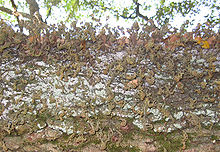Pleopeltis polypodioides
| Pleopeltis polypodioides | |
|---|---|
 |
|
| Polypodium polypodioides on an oak limb after a brief rain | |
 |
|
| Fronds on the same limb in desiccated state | |
| Scientific classification | |
| Kingdom: | Plantae |
| Division: | Pteridophyta |
| Class: | Polypodiopsida/Pteridopsida (disputed) |
| Order: | Polypodiales |
| (unranked): | Eupolypods I |
| Family: | Polypodiaceae |
| Genus: | Pleopeltis |
| Species: | P. polypodioides |
| Binomial name | |
|
Pleopeltis polypodioides (L.) E.G.Andrews & Windham |
|
| Synonyms | |
|
Acrosticum polypodioides L. |
|
Acrosticum polypodioides L.
Pleopeltis polypodioides (syn. Polypodium polypodioides), also known as the resurrection fern, is a species of creeping, coarse-textured fern native to the Americas and Africa.
The evergreen fronds of this fern are 25 cm high by 5 cm wide and monomorphic. The leathery, yellow-green pinnae (leaflets) are deeply pinnatifid, oblong to narrowly lanceolate, usually widest near middle, occasionally at or near base. It attaches to the limbs of its host plant with a branching, creeping, slender rhizome, which grows to 2 mm in diameter. The scales are lanceolate, with light brown base and margins, and having a dark central stripe.
The gametophytes (the haploid gamete producers) of this plant develop from very small spores that float in the air and are deposited on moist tree branches. These spores are produced in sporangia that develop on the leaves of the fern's sporophyte. The fern can also reproduce by the division of its rhizomes.
On the underside of the blades, the sori (reproductive clusters) are round, discrete, and sunken. Their outline can be seen as raised dimples on the upper surface. They are typically near the outer edge, and occur on all but the lowest pinnae of fertile fronds. Indusium is absent. Sporangia are yellow to brown at maturity. Spores are produced from summer to fall.
This fern is an epiphyte, or air plant, which means it attaches itself to other plants and gets its nutrients from the air and from water and nutrients that collect on the outer surface of bark. The resurrection fern lives on the branches of large trees such as cypresses and can often be seen carpeting the shady areas on limbs of large oak trees. However, it is known to grow on the surfaces of rocks and dead logs as well. It is often found in the company of other epiphytic plants such as Spanish moss.
...
Wikipedia

